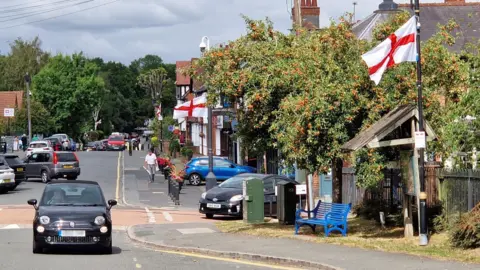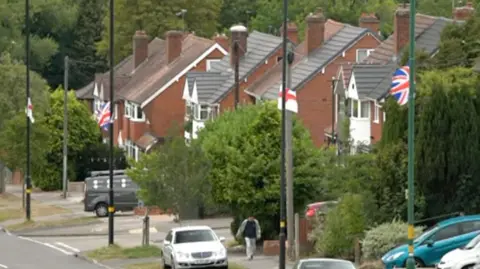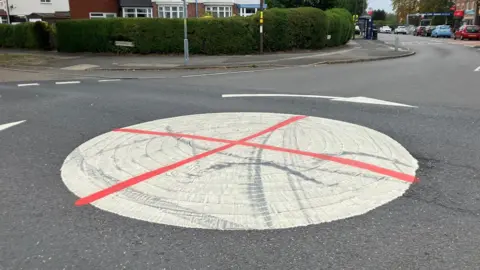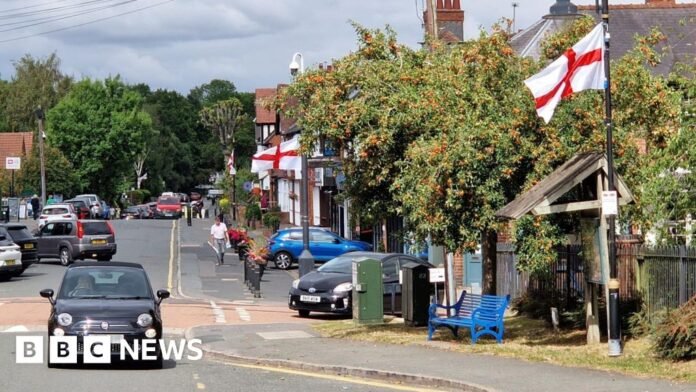BBC News, West Midlands
 BBC
BBCSt George’s and union jack flags have been going up in cities, towns and villages in recent weeks – but why?
While many people were flying the flag to cheer on the Lionesses during the 2025 Euros, thousands more have appeared during August – many attached to lampposts.
Groups responsible for putting up the flags have told the BBC they are motivated by pride and patriotism. But others have said it feels provocative at a time when tensions are running high across England over immigration.
The issue has also caused a headache for councils, with some authorities in the Midlands changing their stances within days over whether flags should be removed from street furniture or not.
At least one police force has launched an investigation into criminal damage after St George’s crosses were painted on mini-roundabouts.
Here’s a look at how the flag debate unfolded.
How did it all begin?
St George’s flags grew in number as the Lionesses’ Euros campaign gathered pace in July.
Weeks later, the suburbs of Weoley Castle and Northfield in Birmingham had a mixture of the St George Cross and union jacks hanging from every lamppost along several of their streets. A few miles away in the villages of Wythall and Hollywood, dozens more appeared almost overnight.
The sight of flags, uniformly flying in a row along residential streets and country lanes, was warmly welcomed by many people commenting on Facebook.
A group calling themselves the Weoley Warriers claimed responsibility, saying they were a “group of proud English men with a common goal to show Birmingham and the rest of the country of how proud we are of our history, freedoms and achievements”.
The fact both flags have been used as emblems for far-right political movements, however, meant some residents in Birmingham were uncomfortable with the motivations of some of those backing the Weoley Warriers’ crusade.
Are the flags being taken down?

There’s been some confusion over this.
After seeing the flags going up rapidly across the city, Birmingham City Council issued a safety plea on 15 August to residents attaching them to lampposts and other street furniture, due to maintenance work being carried out.
A spokesperson said the authority was upgrading streetlights to energy-efficient LED lighting and had so far removed about 200 banners and flags from the streets of the city since the start of the year.
“People who attach unauthorised items to lampposts could be putting their lives and those of motorists and pedestrians at risk,” they said.
However, a number of people took to social media questioning the council’s reasoning for wanting to remove the flags.
There have also been questions over why a small number of Palestinian flags flown from lampposts were not taken down as well.
On Wednesday, the city council confirmed it had not removed any England flags during August.
It said: “We proudly fly the union flag outside the council house every day and recognise the importance of the union flag and flag of St George as symbols of national pride. Brummies are proud to be British and proud that this is a welcoming city celebrating many different cultures.
“When it comes to items attached to lampposts, it is normal council procedure for these to be removed on a regular basis, in line with our health and safety obligations.”
Elsewhere, in Tower Hamlets, London, where flags were put up several days later, council workers were pictured taking some down, prompting fury in the community.
What has happened since?

The suggestion flags would be taken down made a lot of people angry.
Rows of flags started appearing in other towns and villages overnight, including Bromsgrove and Worcester in Worcestershire, Bradford, Newcastle and Norwich.
The movement, fuelled by social media, has got a name – Operation Raise the Colours.
People have been pictured using cherry pickers and ladders to fly the flags as high as possible.
More than £18,000 has been raised to support campaigns to put up union and cross of St George flags in and around Birmingham, while more than 4,000 people have also signed a petition calling for the local authority to stop removing the flags.
One man in Worcester, Tom Conway, told the BBC this week he had put up more than 400 flags himself.
St George’s crosses also appeared painted on roundabouts in Birmingham and Bromsgrove, with a video of one man daubing the road in full view of a police officer.
Some people living in Kings Heath, Birmingham, near one of the roundabouts said it was vandalism the cash-strapped council could not afford to fix – although many on Facebook applauded the mystery artist’s efforts.
On Wednesday, West Mercia Police said it had started a criminal damage investigation over the painting of traffic islands while West Midlands Police confirmed it was looking into the issue.
What else have councils said?

In Worcestershire, Reform UK lead the county council.
In a statement, they said they would not be taking down any of the flags flying from lampposts or other street furniture.
But councillor Karl Perks came out very strongly over the painted roundabouts.
“What I cannot condone are acts of vandalism, costing taxpayers money. This is exactly what the illegal painting of red crosses on local roundabouts will do,” he said.
“This act of vandalism will cost our county council money to rectify. As the cabinet member for highways for Worcestershire County Council, I will be seeking criminal damages so that every other taxpayer in the county does not pay for this.”
A video on social media appears to show at least one roundabout in Bromsgrove with its red cross being covered over with white paint.
Why are some people unhappy about the flags?

While some people living in area where flags have appeared are happy to see the displays, others have said they find them intimidating.
Some have questioned the motive behind the movement, with the St George’s flag being associated with some on the far right.
A man who lives close to Woodthorpe Road, in Kings Heath, where a roundabout was vandalised, stated it was “not patriotic, it just feels like an excuse for xenophobia”.
“There are better ways to show pride – ways that are inclusive and respectful, not resorting to vandalism,” he said.
Another woman living in Kings Heath said: “They make me feel very uncomfortable and do not represent me.”
The reason why some associate the flag with far right groups, vexillologist (one who studies flags) Malcom Farrow said, is because Britain has never been a nation that has flown flags often and so “nutter extremists” have been able to hijack them as their own symbols.
Moseley resident and political activist Femi Olawale added those who have done the most damage to the reputation of the flag are those “who use it to justify movements that end up damaging the UK, that end up dividing us as a country”.
Sabiha Aziz, a local campaigner from Acocks Green, said it was a “crying shame” that the “far right” had exploited the flags, so that they “symbolise hate and division”.
Her views were supported by a number of people who spoke to the BBC.
What has the government said?
Labour frontbenchers have not waded into the debate in much volume.
On Monday, Sir Keir Starmer’s official spokesman said: “I think the PM has always talked about his pride of being British, the patriotism he feels.
“Patriotism will always be an important thing to him.”
What is the law around flying flags?
Helpfully, the government has a guide on its website – a “plain English” guide to flying flags.
It states flags are a “very British way of expressing joy and pride” which are “emotive symbols which can boost local and national identities, strengthen community cohesion and mark civic pride”.
It also states that the government “wants to see more flags flown, particularly the Union Flag, the flag of the United Kingdom – it is a symbol of national unity and pride”.
In England, the flying of flags is treated as advertisements in council legislation to ensure they do not impact on safety and are flown in a convenient location. Some flags require formal consent from the local planning authority, but crucially, the union jack and the St George’s cross do not.
But this is the key thing in the current climate – it states all flags must “have the permission of the owner of the site on which they are displayed – this includes the highway authority if the sign is to be placed on highway land”.
The Highways Act 1980 states it is an offence to affix items to structures on the highway without the consent of the highway authority, without reasonable excuse.
Under section 132(2) of the act, it states the highway authority can remove any such items.






